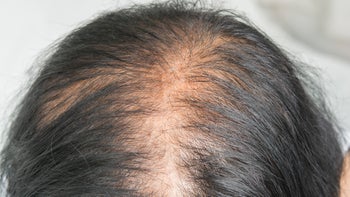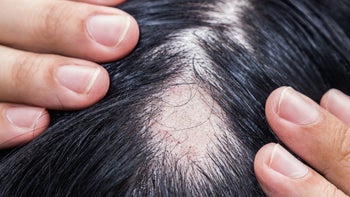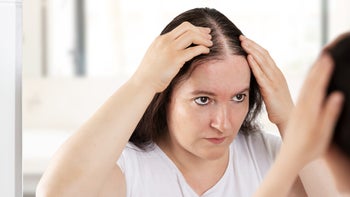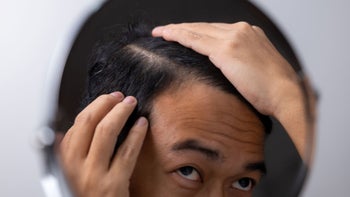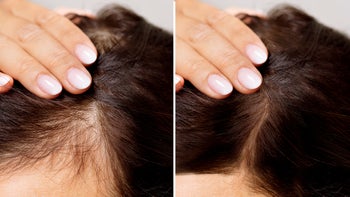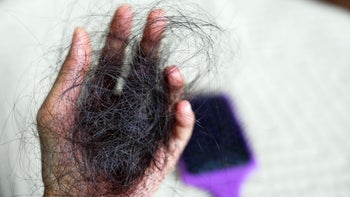
How Does Ketoconazole Work for Hair Loss?
Key takeaways:
Different life circumstances can contribute to hair loss. Age, stress, and certain health conditions are all common causes.
Propecia (finasteride) and Rogaine (minoxidil) are common first-choice medications for treating hair loss. They aren’t helpful or sufficient for everyone, though.
Ketoconazole shampoo isn’t FDA approved to treat hair loss. But some studies have found that it might be a beneficial option.
Access savings on related medications
Table of contents
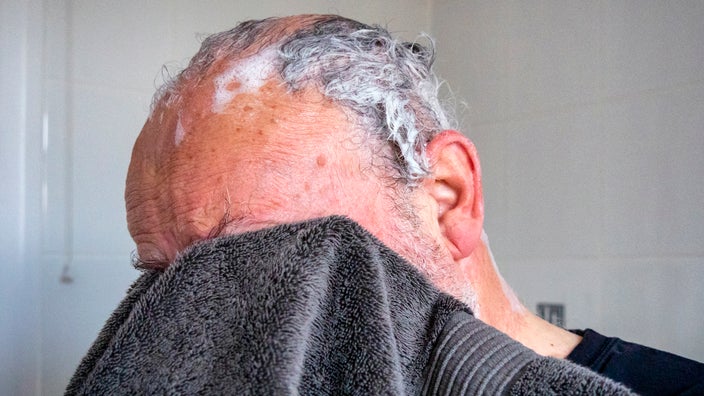
There are many reasons why you might lose your hair. Age, stress, and certain health conditions are just a few. Some medications are available to help prevent further hair loss, while others may help you regrow your hair. You’ve likely seen advertisements for these products on the internet, on TV, or even in some magazines.
It’s used less often than other hair-loss medications, but some evidence suggests ketoconazole shampoo may also treat hair loss. If you’ve ever used ketoconazole, chances are that it was to treat a skin condition or a dry and flaky scalp. But if you’re looking for another option to treat hair loss, medications like ketoconazole may be top of mind.
Here, we’ll discuss the research on using ketoconazole for hair loss and if it might be helpful for you.
SHINGRIX (Zoster Vaccine Recombinant, Adjuvanted) is now $0 for almost everyone*
Get SHINGRIX at the pharmacy or in-network doctor’s office today. 98% of privately insured people pay $0 and all Medicare Part D beneficiaries pay $0 at the pharmacy.
Prescribing Information
*Coverage and cost may vary and are subject to change without notice. Reimbursement decisions are made by individual insurance plans.


SHINGRIX is an FDA-approved vaccine for the prevention of shingles (herpes zoster) in adults 50 years and older. SHINGRIX is not used to prevent chickenpox.
• You should not receive SHINGRIX if you are allergic to any of its ingredients or had an allergic reaction to a previous dose of SHINGRIX
• An increased risk of Guillain-Barré syndrome (severe muscle weakness) was observed after vaccination with SHINGRIX
• Fainting can happen after getting injectable vaccines, including SHINGRIX. Precautions should be taken to avoid falling and injury due to fainting
• The most common side effects are pain, redness, and swelling at the injection site, muscle pain, tiredness, headache, shivering, fever, and upset stomach
• SHINGRIX was not studied in pregnant or nursing women. Tell your healthcare provider if you are pregnant, plan to become pregnant, or are breastfeeding
• Vaccination with SHINGRIX may not protect all individuals
• Ask your healthcare provider about the risks and benefits of SHINGRIX. Only a healthcare provider can decide if SHINGRIX is right for you
You are encouraged to report vaccine adverse events to the US Department of Health and Human Services. Visit www.vaers.hhs.gov to file a report, or call 1-800-822-7967.
For US audiences.
Trademarks are property of their respective owners.
©️2024 GSK or licensor.
PMUS-SGXWCNT240015 May 2024
Produced in the USA.
GoodRx Health information and resources are reviewed by our editorial staff with medical and healthcare policy and pricing experience. See our editorial policy for more detail. We also provide access to services offered by GoodRx and our partners when we think these services might be useful to our visitors. We may receive compensation when a user decides to leverage these services, but making them available does not influence the medical content our editorial staff provides.
What is ketoconazole?
Ketoconazole is a medication that’s available over the counter (OTC) and with a prescription. It’s available in many different formulations and dosages. It also treats a variety of health conditions.
As a prescription cream, ketoconazole treats fungal infections such as ringworm, athlete’s foot, and jock itch. The foam and gel versions of ketoconazole treat seborrheic dermatitis, which is very similar to dandruff. Ketoconazole oral tablets treat several other fungal infections.
As a prescription shampoo, ketoconazole is approved to treat discolored patches of skin on your scalp (tinea versicolor). It’s also available OTC to lessen scalp flaking, scaling, or itching caused by dandruff.
Ketoconazole shampoo is the main version of ketoconazole that’s been studied for hair loss. The cream, gel, and other formulations haven’t been studied for hair loss.
Can ketoconazole support hair growth?
Maybe. Even though ketoconazole isn’t FDA approved to treat hair loss, some evidence suggests that it might help.
How does ketoconazole work for hair loss?
Dihydrotestosterone (DHT) is a hormone suspected to cause hair loss in men as they get older. Testosterone, a very similar hormone, is converted to DHT with the help of an enzyme (protein) called 5-alpha reductase (5AR).
Your hair loss questions, answered: Learn about possible causes of hair loss, effective treatments that can help reverse it, and the truth about hair-loss supplements.
Hair products to avoid: Get the scoop on shampoos that may cause your hair to fall out.
Proven solutions for hair growth: Discover clinically effective treatments that can help you on your journey to get thicker, fuller hair.
Ketoconazole is thought to work by blocking the action of 5AR in your body. Ketoconazole lowers DHT levels and may help slow hair loss by doing this. It may even support hair growth.
Good to know: This strategy is very similar to Propecia (finasteride), another medication that blocks 5AR. But unlike ketoconazole, Propecia is officially approved to treat male-pattern baldness.
Ketoconazole shampoos
Ketoconazole shampoo is available OTC and with a prescription. Nizoral A-D is an OTC anti-dandruff shampoo that contains ketoconazole 1%. Ketoconazole 2% shampoo is prescription only and treats conditions such as fungal skin infections.
Ketoconazole 1% and 2% shampoos have both been studied as off-label treatments for hair loss. But ketoconazole 2% may be slightly better for this use.
Is ketoconazole actually an effective option for hair loss?
We don’t know for sure. Some studies suggest ketoconazole may be an effective option for hair loss, but it’s not approved for this use.
One study compared ketoconazole 2% shampoo to minoxidil 2% topical solution (Rogaine) — another medication used to treat hair loss. The study found that hair thickness and size improved at a similar rate between both products. The study also suggested that ketoconazole may have anti-inflammatory effects against Malassezia, a fungus that could play a role in hair loss.
Another study compared oral finasteride, minoxidil 2% topical solution, and ketoconazole 2% shampoo to each other. After 1 year, study participants taking finasteride and minoxidil together had the best results. But people who took finasteride alone or in combination with minoxidil or ketoconazole had better results than those taking minoxidil alone. This is why many people often use ketoconazole in addition to finasteride or minoxidil. There were no serious side effects observed in this study.
Ketoconazole has also been tested for hair growth in an animal study. Ketoconazole was applied to the gently clipped hair of mice once daily for 3 weeks. The study showed significant hair growth in the mice.
With all of this in mind, there’s preliminary evidence to support the use of ketoconazole for hair loss. But this data isn’t fully conclusive. More studies are needed to determine if ketoconazole is actually effective for treating hair loss.
How often can you use ketoconazole shampoos for hair growth?
Since ketoconazole shampoo isn’t approved for hair loss, there are no established directions for its use. Still, people included in studies who had positive results with ketoconazole used the shampoo once every 2 to 4 days. The shampoo was left in their hair for 3 to 5 minutes before being rinsed out.
If you’re interested in trying ketoconazole for hair loss, it’s recommended to talk to a healthcare professional first. Based upon your situation, they can tell you more about what your best treatment option(s) may look like. Since other medications aside from ketoconazole shampoo have been more widely studied for hair loss, they may recommend a different treatment option altogether.
How to use ketoconazole shampoo effectively for hair loss
Seeing a healthcare professional and getting a ketoconazole prescription is a great first step to combatting hair loss. Follow your prescriber’s instructions closely to ensure that you get the most out of your treatment.
Start off by wetting your hair. Then, ensure your skin and hair are damp before applying ketoconazole. Squeeze a small amount of ketoconazole shampoo into your hand — about the size of a dime. Apply it to your scalp and lather it generously, similar to any other shampoo.
Leave ketoconazole shampoo in your hair for about 5 minutes before rinsing it out. You can apply your next dose in 2 to 4 days, depending on your prescriber’s specific instructions.
Pro tip: You may not have used enough ketoconazole shampoo if you’re unable to form a lather. On the other hand, you may have applied too much if you were easily able to form a lather and you still have a lot of shampoo leftover in your hands.
Frequently asked questions
More isn’t necessarily better when it comes to ketoconazole for hair loss. You’ll typically apply ketoconazole once every 2 to 4 days and leave it on your scalp for about 3 to 5 minutes before rinsing it out. Applying ketoconazole more frequently or for longer periods of time probably won’t help you preserve more hair. And while there isn’t much data available regarding excessive ketoconazole shampoo use, we do know that too much may cause you to experience more side effects, such as an itchy or dry scalp.
You’ll know ketoconazole is working if you’re shedding less hair over time. But results won’t come right away. So if you don’t notice a thicker scalp after a few weeks of applying ketoconazole shampoo, don’t fret. It can take up to 6 months before you see results. Reach out to a dermatologist or another healthcare professional if you’ve been applying 2% ketoconazole shampoo for 6 months or longer and haven’t seen any improvements.
You’ve likely seen many shampoo advertisements that claim to stop or reverse hair loss. But it's good to keep a skeptical eye when reviewing OTC product labels; many of them don’t contain an active ingredient or medication for hair loss. They’re also not FDA approved and may not have any clinical evidence to support their claims. Ketoconazole shampoo is one of the few shampoos that may be beneficial for hair loss.
Not usually. Hair loss isn’t a common side effect of ketoconazole shampoo. However, ketoconazole shampoo may cause side effects like dry or oily hair or a dry scalp, which may result in itchy hair. An itchy scalp may worsen your scalp’s sensitivity and can lead to hair loss.
The bottom line
Medications like Rogaine (minoxidil) and Propecia (finasteride) are frequently used to treat hair loss. The possible effectiveness of ketoconazole shampoo for hair loss has been observed in a few studies, but it's not FDA approved for this use. It’s recommended to talk to a healthcare professional if you’re interested in trying ketoconazole shampoo for hair loss.
Why trust our experts?



References
Bryant Ranch Prepack. (2022). Ketoconazole shampoo, suspension [package insert].
Fields, J. R., et al. (2020). Topical ketoconazole for the treatment of androgenetic alopecia: A systematic review. Dermatologic Therapy.
Jiang, J., et al. (2014). Topical application of ketoconazole stimulates hair growth in C3H/HeN mice. The Journal of Dermatology.
Khandpur, S., et al. (2014). Comparative efficacy of various treatment regimens for androgenetic alopecia in men. The Journal of Dermatology.
Kinter, K. J., et al. (2023). Biochemistry, dihydrotestosterone. StatPearls.
Kramer Laboratories. (2021). Nizoral- ketoconazole shampoo [package insert].
Piérard-Franchimont, C., et al. (1998). Ketoconazole shampoo: Effect of long-term use in androgenic alopecia. Dermatology.
Piérard-Franchimont, C., et al. (2002). Nudging hair shedding by antidandruff shampoos. A comparison of 1% ketoconazole, 1% piroctone olamine and 1% zinc pyrithione formulations. International Journal of Cosmetic Science.
Rafi, A. W., et al. (2011). Pilot study of 15 patients receiving a new treatment regimen for androgenic alopecia: The effects of atopy on AGA. International Scholarly Research Notices.
Sinawe, H., et al. (2023). Ketoconazole. StatPearls.
Trüeb, R. M., et al. (2018). Scalp condition impacts hair growth and retention via oxidative stress. International Journal of Trichology.
Vázquez-Herrera, N. E., et al. (2017). Scalp itch: A systematic review. Skin Appendage Disorders.


